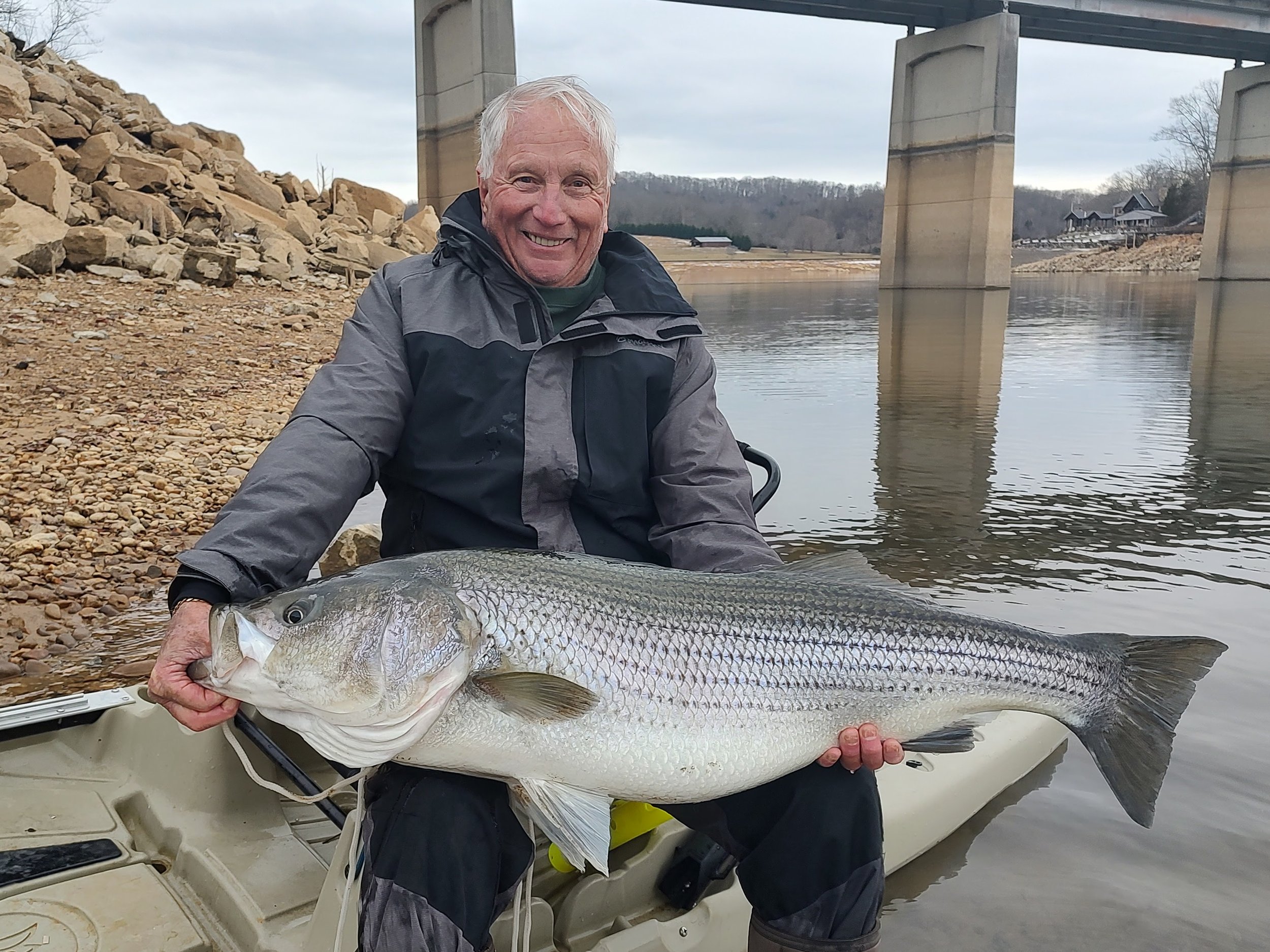The Tanks of Boone Lake
Angler James Shupe is hooked on hooking striped bass near his home in Johnson City.
Credit: James Shupe
Thirty-pound braid was steadily being stripped from my reel and my 12-foot jon boat was being towed around by an unseen finny tank.
I had flashbacks to my off-shore days of being hooked up to a huge cobia, but this experience was even more surreal because I was on Boone Lake, which was close to my home in Johnson City, Tennessee.
Boone Lake is a 4,520 acre TVA reservoir located in northeast Tennessee. The dam is located on the South Fork of the Holston River and was created in 1952. The major tributaries are the Watauga and South Fork of the Holston rivers.
Although relatively small, Boone Lake is fertile enough to support large numbers of sport fish. Boone also has an abundant forage base of threadfin shad. These shad are high in protein and relatively easy for any gamefish to catch.
Since Boone can support high densities of fish, the (Tennessee Wildlife Resources Agency) has stocked blue catfish, striped bass, hybrid striped bass, and black crappie. Largemouth and smallmouth bass, striped bass, hybrid striped bass, and catfish are the predominant gamefish in Boone.
Two years ago I was stricken with striped bass syndrome, and the only relief from this affliction I could find was to fish at least once a week long and hard for these magnificent monsters.The one exception to my striper obsession is the summer. Striped bass are notoriously inactive in the summer due to the bright sunlight and intense heat.
Over the past two years, I have gradually simplified and refined my fishing and rigging strategies for the tanks of Boone Lake. I have chosen to be a minimalist angler, and I have reduced to a bare minimum everything I carry in my small 12-foot jon boat. The only electronic equipment I use is my bow-mounted trolling motor. The remaining items are four medium-heavy spinning outfits, four planer boards, a small tackle box, a two-gallon aerated bait bucket, and a large landing net specifically made for big stripers.
As a bare-bones fisherman, I can “listen” to nature and observe my surroundings. I enjoy the solitude and blending in with the environment. Because of my quiet approach I am able to see deer, turkeys, and eagles on a regular basis. Instead of an electronic screen, I focus on the contours of the shoreline and possible ambush points for solitary tanks.
Steep banks are my go-to favorite structure to fish. It is relatively easy for big stripers to remain in deeper water while having the ability to trap baitfish against a steep bank. It is not uncommon for me to go three or four days without a strike, but when a tank abruptly begins to tow my boat around, all of the “bad” days are soon forgotten.
My four spinning outfits exactly match, as it is important for me to have familiar tackle in my hands when a monster striper is ripping line and pushing all rigging to the breaking point. My rods are the seven-foot Shakespeare “Ugly Stick Catfish” model in the medium-heavy action. These rods have plenty of backbone and are noted for their ability to withstand plenty of abuse. My matching reels are the Shimano Sedona model in the 6000 series. These are actually light saltwater reels designed to hold plenty of 30-pound braid and they feature a heavy-duty drag system for oversized fish.
My line of choice is Suffix 832 30-pound braid due to the small diameter and the high reviews by anglers for its use with spinning tackle. Another important feature is that this line maintains surface tension and floats when I’m in a tug-of-war with a tank. I’ll usually have at least two planer board rigs floating around while engaged with a big striper and keeping track of the floating braid from these rigs enables me to minimize tangles throughout the slugfest.
I am very particular about my knots and rigging as there is no margin for error when my boat is being towed around by one of these finny brutes. I prefer to fish between 15 to 20 feet deep below my planer boards. For this reason, I tie 25 feet of 20-pound monofilament to my 30-pound braid with a double uni-knot. I wet all knots and pull down on each one as hard as I can to ensure no slippage. I then put on a quarter-ounce weight and a quality swivel. A five-foot length of fluorocarbon and a 4/0 Owner offset circle hook completes my rigging process. For all of my other knots I use the Trilene knot, which has an almost 100 percent breaking strength.
I am able to gauge the depth below my planer boards by the 25 feet of 20-pound monofilament tied to the braid. I can clip on my planer boards an approximate distance from the braid to attain my 15 or 20 feet preferred depth.
Waterbugz planer boards are well-suited for striper fishing, and they freely slide up and down the line once the clip has snapped from the strike. These planer boards are maintenance free and will withstand rigorous use.
Medium to large shiners are my live bait preference. I prefer to hook them through the nose because they are easily pulled off the hook when hooked through the lips.
Boone is also loaded with huge brown trout. They are so numerous, in fact, that I sometimes consider them a nuisance. I have also caught some big hybrid striped bass while trolling for stripers. These hybrids fight like a striper, and typically an angler cannot tell the difference until the fish is in the landing net.
Hopefully my experiences and techniques will jump start you into becoming addicted to the tanks of Boone Lake.

